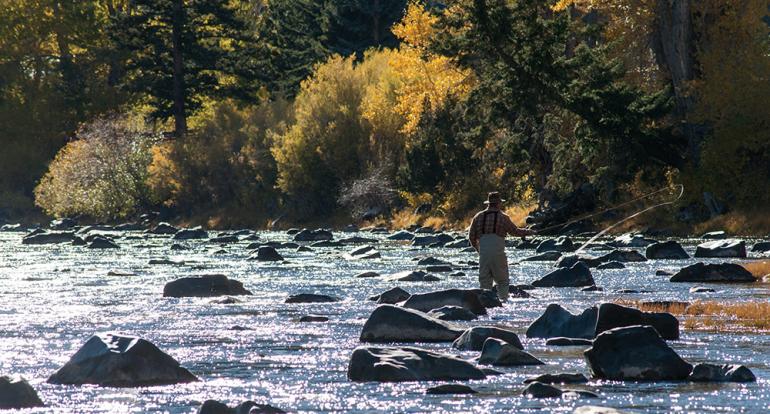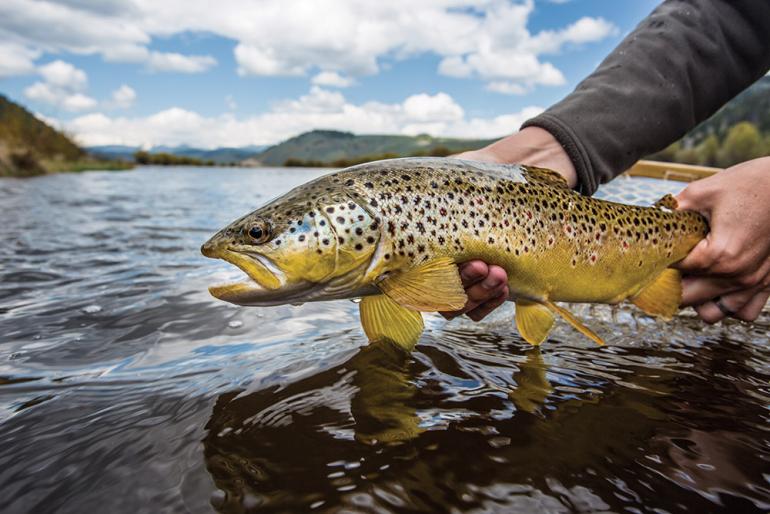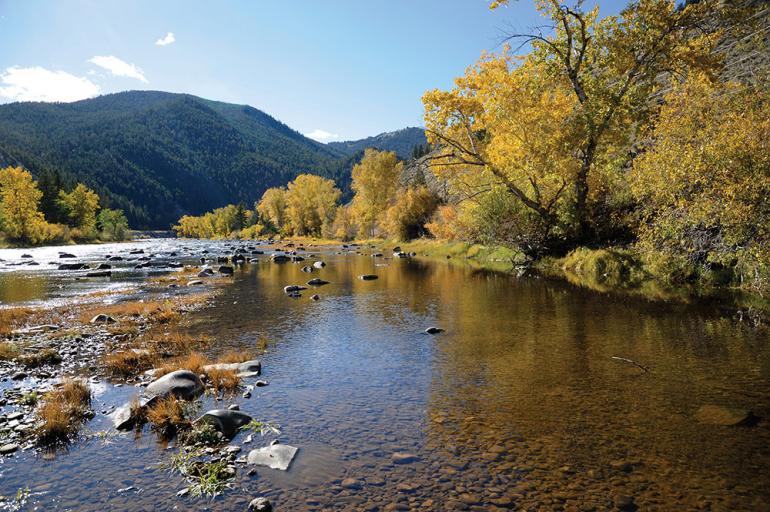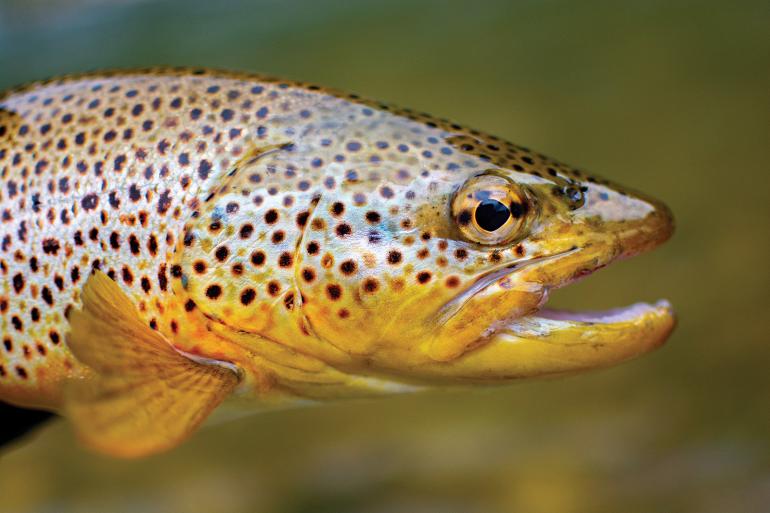Brown & Out
Exploring the mystery of Montana's disappearing trout.
Wily, adaptable, and persistent in the face of human abuses, brown trout are the aquatic version of coyotes. That’s why Wade Fellin, co-owner of the Big Hole Lodge in Wise River, thought they would be the last fish to vanish from southwest Montana’s rivers.
Fellin has been intimately connected to the region’s famous trout streams his entire life, starting when his mother went into labor with him in Wise River 33 years ago. For the last 15 years, he’s spent over 100 days per year guiding anglers on the Big Hole, Beaverhead, and Missouri rivers. Over that time, he says that a good day of fishing has gone from 25 fish per day, per angler, to 6-10 fish now. There are multiple reasons for this, according to Fellin, and a lot of unknowns. “But one thing is clear,” he says. “There’s a disproportionate decline in brown trout.”
Flexible Fish
In contrast with other salmonid species that inhabit Montana’s waters, such as bull trout and cutthroat trout, brown trout don’t require exceptionally clean, cold water to survive. The water just needs to be clean and cold enough. I’ve had some memorable days fishing on the East Gallatin River below the Bozeman wastewater treatment plant and in the Clark Fork River downstream of the heavy-metal-laden Warm Springs Ponds. In both places, there were plenty of browns to be caught.
But brown trout are also the most difficult trout to catch, as most seasoned anglers will attest. Biologists attribute their shrewdness to the design of their retinas, which are optimized to function in low-light conditions, such as beneath undercut banks and during the dark of night, when they are known to snatch mice, voles, and baby birds from the surface.
Then there’s the fact that they adapt well to new environments—just look how far and wide they’ve spread in Montana since they were introduced to the Madison River in 1889. Native to Europe, North Africa, and West Asia, brown trout have expanded across the planet, exhibiting a wide range of evolutionary adaptations that allow them to thrive in streams, lakes, and even the ocean, where their life cycle is similar to a salmon’s. The world’s foremost wild-trout expert, the late Dr. Bob Behnke, described them as “one of the most genetically diverse vertebrates known.” Some biologists have proposed dividing brown trout into 50 unique species.
Strange Disappearance
Last spring, after more than 800 whitefish, brown, and rainbow trout were found dead of mysterious causes in the Beartrap Canyon stretch of the Madison River, newspapers across the state ran stories about the disappearance of brown trout from southwest Montana’s rivers. Soon after, I started sleuthing around to figure out if this was just a cyclical blip or something bigger.
Sure enough, the data showed brown-trout populations plummeting across the troutiest portion of the state, with the epicenter of the decline in the storied waters that join to form the Missouri River. On the lower Madison by Norris, brown trout numbers hit a 20-year low of 459 fish per mile this year. On the most popular reach of the Big Hole near Melrose, in Fellin’s back yard, numbers plunged by 80 percent, from 1,800 fish per mile in 2014 to 400 per mile this year. Over the same period, brown trout declined by 60 percent in the Ruby River below the dam (from 1,500 to 600 fish per mile) and by 50 percent in the Beaverhead River (from 2,000 to 1,000).
Just across the Continental Divide, the upper Clark Fork River suffered the steepest decline of all, going from 1,800 brown trout per mile in 2013 to a mere 82 in 2019. As brown trout have disappeared from the upper Clark Fork, so too have their main avian predators. Osprey numbers have nosedived by 65 percent.
What’s most concerning to biologists is that it’s not just adult brown trout that are vanishing from these rivers—juvenile fish aren’t showing up, either. Fewer juvenile fish mean fewer adult fish down the road.
Heating Up
Fisheries biologists aren’t certain why brown-trout numbers are plummeting across southwest Montana, but the low flows and high water temperatures associated with climate change are a pretty good bet. Since 1950, western mountain snowpacks have dwindled by 25 percent, and peak runoff is now occurring eight days earlier in the Greater Yellowstone Area. Consequently, streamflows are bottoming out earlier in the summer and water temperatures are rising lethally high for weeks on end. Those trends are expected to accelerate, scientists say.
“Climate models run for Montana and the Greater Yellowstone Region are quite clear: our streams will be even warmer than now and have less flow in the decades ahead,” says Dr. Cathy Whitlock, Regents Professor Emerita at Montana State University and co-lead-author of the recently published “Greater Yellowstone Climate Assessment.”
Trout generally can’t tolerate water temperatures higher than 68 degrees Fahrenheit for extended periods, and that’s without the added stress coming from angling pressure. Warm water has less dissolved oxygen, makes trout more susceptible to parasites and disease, and is prone to algae blooms that further deplete the water’s oxygen levels.
High water temperatures were implicated in the massive fish-kill that occurred on the upper Yellowstone River in August 2016, when an estimated 10,000 whitefish went belly-up from an outbreak of proliferative kidney disease (PKD). While no major PKD outbreaks have been detected in the headwaters of the Missouri, anglers this summer reported seeing unusually high numbers of dead fish, as well as fish with lesions on them.
But those are just the direct impacts that climate change is having on brown trout. Indirect impacts come in the form of disturbance events such as wildfires, droughts, and floods, which have become much more frequent and severe as of late. Although wildfires are a natural occurrence in the West, benefiting brown trout and other fish by burning down large trees that fall into rivers and become habitat, catastrophic wildfires fueled by climate change often trigger large landslides that smother spawning gravels with sediment. Likewise, normal springtime floods benefit trout by eroding new side-channels, building new islands, and toppling large trees that provide instream cover for trout. But when major rain-on-snow events occur in late winter, as is becoming more common in Montana’s lower and middle elevations, they can scour brown-trout nests when the eggs are still incubating in the gravel.
Not So Fast
But there’s more to the story. If climate change is solely responsible for the disappearance of brown trout across southwest Montana, one would think that it would be affecting rainbow and cutthroat trout in the same manner. Because rainbows and cutthroats are spring-spawning fish whose eggs hatch in early summer, when flows are lower and hotter as a result of irrigation withdrawals, they should be taking an even bigger hit than brown trout, which spawn in the fall.
Furthermore, if climate change is the chief culprit, it should be decimating brown-trout populations in other rivers throughout the West. But a review of the data from the past two decades shows that brown trout are holding their own—even thriving—in many of the most revered Western haunts. Some of these are dam-regulated rivers like the Bighorn, Missouri, North Platte, and the Henry’s Fork and South Fork of the Snake; and some are freestone rivers like the Smith River in Montana and the upper Green River in Wyoming.
Pat Byorth, a retired fisheries biologist who is now Trout Unlimited’s Montana Water Director, believes that while climate change is certainly a factor, an important element to consider is a change in local agricultural practices.
In essence, as many ranchers in southwest Montana have converted from flood irrigation to sprinkler irrigation over the past few decades to conserve water and expand irrigated acreage, the highly altered hydrologic regime to which brown trout have become accustomed over the last century has changed, too. That, combined with the obvious effects of climate change, may be too much for even a resilient species like brown trout to overcome.
“After 40 years of relatively stable wild-brown-trout populations in southwest Montana, this sudden decline in adult and juvenile brown trout signals a significant shift, most likely in habitat,” Byorth says. “The largest change has come in streamflows and water temperatures. The major shift in hydrology due to longer, hotter, and drier summers means brown trout go into spawning season—and into winter—in poorer condition, with less groundwater upwelling for ice-free egg incubation. It could be a perfect storm of less water supply, hotter summers, and a shift to more efficient center-pivot irrigation that lessens groundwater recharge.”
The important words here are “could be”—at this point, it’s still just educated speculation. And until a smoking gun is found, biologists continue to investigate other factors that may be contributing to the decline. These include water pollution from chemicals used in farming and ranching operations, and dramatically increased angling pressure—which Fellin adamantly believes is a problem, to the point that he has reduced the number of clients that he and his fellow guides take down the river each day. “I’ve seen the enemy,” he says, “and it is us.”
Into the Future
Whatever the culprit is, fisheries managers, conservation groups, and the fly-fishing industry aren’t waiting for a definitive answer before taking action. Montana Fish, Wildlife & Parks is soliciting public comment on proposed new fishing regulations that could include catch-and-release fishing only, the use of only single barbless hooks, and fishing closures from fall through winter to protect spawning brown trout.
And in late July, several conservation groups led by Upper Missouri Waterkeeper, American Rivers, and the Greater Yellowstone Coalition, joined by prominent fishing manufacturers Orvis and Patagonia, among others, sent a letter to Governor Greg Gianforte asking him to convene a Cold Water Fisheries Task Force to identify the causes of the crisis and come up with strategies to resolve it.
|
|
For Fellin, the mystery remains at the forefront of his livelihood. A year ago, in the midst of a global pandemic, he was worried about getting enough clients to pay the bills. This year, the continued decline in brown trout comes on the heels of a wildfire season that scorched over 10,000 acres in the Pioneer Mountains, just up the road from his family’s fishing lodge.
“We’re recovering from the pandemic, and we can rebuild if the nearby wildfires burn us down,” he says. “but without healthy brown-trout populations in our local rivers, Big Hole Lodge faces its toughest challenge yet."
Scott Bosse is the Northern Rockies Director at American Rivers and an avid angler who has fished for trout across southwest Montana for nearly three decades.



















